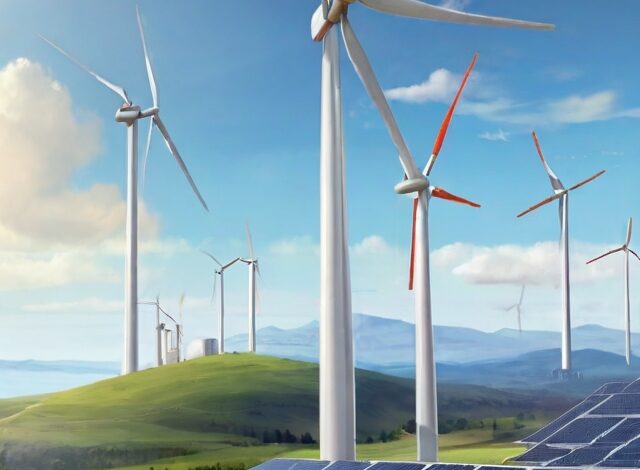Emerging technologies in renewable energy sector

Introduction
The Current State of Renewable Energy
The renewable energy sector is witnessing an unprecedented era of growth and innovation. Global concerns about climate change and the diminishing reserves of fossil fuels have catalyzed a significant shift towards sustainable energy sources. Today, renewable energy not only represents an environmentally friendly alternative but has also become economically viable, challenging traditional energy sources like coal and natural gas.
Renewable energy, encompassing solar, wind, hydro, geothermal, and biomass, is rapidly evolving. The International Energy Agency (IEA) reports that renewables are set to account for almost 95% of the increase in global power capacity through 2025. This surge is propelled by technological advancements, supportive policies, and increasing societal demand for green energy.
The Role of Innovation and Technology
Innovation in technology is at the heart of this transformation. Breakthroughs in materials science, data analytics, and engineering are making renewable energy sources more efficient, reliable, and affordable. The adoption of digital technologies like artificial intelligence (AI) and the Internet of Things (IoT) is optimizing energy production and distribution, making renewables more accessible than ever.
The ongoing research and development in renewable energy technologies are not only enhancing existing methods but are also paving the way for entirely new approaches to energy generation and management. From floating solar farms to bladeless wind turbines, the future of renewable energy is being reimagined.
As we delve deeper into specific renewable energy technologies, it becomes evident that we are standing on the brink of a green revolution. A revolution that promises not only to reshape our energy landscape but also to play a pivotal role in combating climate change and promoting global sustainability.
Solar Energy Innovations
Advancements in Solar Panel Efficiency and Materials
Solar energy has experienced remarkable advancements, particularly in photovoltaic (PV) technology. Modern solar panels are not only more efficient but also more versatile than their predecessors. The efficiency of solar panels has significantly increased, with some models now exceeding 22% efficiency in converting sunlight into electricity.
Emerging materials like perovskite offer promising prospects for future solar panels. These materials are not only cheaper to produce but also more efficient in certain conditions than traditional silicon-based panels. Additionally, innovations in thin-film solar technology are enabling the integration of solar cells into windows, vehicles, and even clothing, opening up new avenues for harnessing solar energy.
Integration of Solar Energy in Urban and Rural Settings
Solar energy is becoming increasingly integrated into both urban and rural settings. In urban areas, rooftop solar installations and solar-powered street lights are becoming common. These installations not only reduce the dependency on the grid but also help in reducing the urban heat island effect.
In rural areas, solar energy is revolutionizing lives by providing electricity to communities that were previously off-grid. Solar-powered water pumps, lighting, and heating systems are improving living standards in remote areas, promoting sustainable development.
Emerging Trends in Solar Energy Storage Solutions
The intermittent nature of solar energy has led to significant developments in energy storage solutions. The advancement in battery technology, especially lithium-ion batteries, has made solar energy more reliable and consistent. These batteries can store excess solar energy generated during the day, making it available for use during night or cloudy days.
Newer technologies like flow batteries and molten-salt storage offer alternatives to traditional battery systems, potentially offering higher capacity and longer life spans. These advancements are crucial in addressing one of the primary challenges of solar energy – ensuring a consistent and stable energy supply.
Wind Energy Developments
Innovations in Offshore Wind Turbine Technology
The offshore wind energy sector is witnessing a surge in technological advancements. These innovations are not only making turbines more powerful and efficient but also more adaptable to various marine environments. One of the key developments is the design of larger turbines with longer blades, capable of capturing more wind energy. The increased size and efficiency of these turbines have led to a substantial decrease in the cost of offshore wind energy.
Floating wind turbines are another groundbreaking innovation. Unlike traditional turbines anchored to the ocean floor, floating turbines can be situated in deeper waters, tapping into stronger and more consistent wind streams. This technology significantly expands the potential geographical range for offshore wind farms.
Enhancements in Wind Energy Capture and Storage
Technological advancements are not just limited to turbine design; they also encompass the way wind energy is captured and stored. Modern turbines are equipped with sophisticated sensors and control systems, allowing them to adjust to changing wind conditions actively. This maximizes efficiency and reduces wear and tear, prolonging the lifespan of the turbines.
In terms of storage, wind energy can be stored in several ways, including battery storage, pumped hydro storage, and even converting wind energy into hydrogen. These storage solutions are crucial for managing the variability of wind energy and ensuring a steady supply to the grid.
The Role of AI and Machine Learning in Optimizing Wind Farm Performance
Artificial Intelligence (AI) and Machine Learning (ML) are playing an increasingly important role in the wind energy sector. These technologies are used for predictive maintenance, which helps in identifying potential issues in turbines before they lead to breakdowns. This not only reduces maintenance costs but also increases the overall efficiency of wind farms.
AI algorithms can also optimize the performance of wind farms by analyzing weather data and adjusting turbine operations accordingly. This ensures that each turbine operates at its optimal capacity, considering the wind conditions at any given moment.
Furthermore, AI and ML are instrumental in the design phase of wind turbines and wind farms. By simulating different scenarios and analyzing vast amounts of data, these technologies can assist in creating more efficient turbine designs and in deciding the optimal layout for wind farms.
Hydropower and Marine Energy
Advances in Small-Scale Hydropower Systems
The realm of hydropower is experiencing a shift towards smaller, more environmentally friendly systems. Small-scale hydropower plants, which have a lesser environmental footprint than large dams, are becoming increasingly popular, especially in remote areas. These systems are designed to harness energy from small rivers or streams without significantly disrupting the ecosystem. Innovations in turbine design have made these small-scale installations more efficient and cost-effective, broadening their applicability.
Exploration of Tidal and Wave Energy Technologies
Tidal and wave energy represent a less tapped but highly promising area of marine renewable energy. Unlike solar and wind energy, tidal and wave energy are more predictable and consistent. Recent technological advances are focused on developing more resilient and efficient tidal turbines and wave energy converters that can withstand harsh marine environments while maximizing energy capture. Floating wave energy devices, which capture the energy of surface waves, are particularly noteworthy for their potential to generate substantial amounts of electricity with minimal environmental impact.
Environmental Considerations and Solutions in Marine Energy
Environmental sustainability is a key focus in the development of marine energy technologies. Research is ongoing to ensure that the deployment of tidal and wave energy systems minimizes impact on marine life and ecosystems. This includes designing turbines that are safe for marine animals and developing installation methods that cause minimal disturbance to the seabed. Additionally, there’s an increasing emphasis on understanding the long-term ecological impacts of these technologies to ensure a harmonious balance between energy generation and environmental preservation.
Geothermal Energy Breakthroughs
New Techniques in Geothermal Drilling and Energy Extraction
Geothermal energy, derived from the Earth’s heat, is being revolutionized by advancements in drilling technologies. Enhanced Geothermal Systems (EGS) are a significant breakthrough, allowing access to deep geothermal resources that were previously uneconomical or difficult to exploit. EGS involves injecting water into hot rocks deep underground to produce steam, which is then used to generate electricity. This technique opens up new possibilities for geothermal energy in regions without traditional geothermal resources.
Geothermal Heating and Cooling Systems for Residential and Commercial Use
Geothermal energy is also making strides in heating and cooling solutions. Ground-source heat pumps, which use the stable temperature of the earth to heat and cool buildings, are becoming more popular due to their efficiency and low operating costs. These systems are suitable for a wide range of climates and have the potential to significantly reduce the carbon footprint of residential and commercial buildings.
The Potential for Geothermal Energy in Different Geographical Regions
The potential for geothermal energy extends beyond traditional hotspots like Iceland or New Zealand. Advances in technology are making it feasible to harness geothermal energy in a diverse range of geographical locations. Countries with volcanic activity or hot springs are obvious candidates, but advancements in EGS technology mean that geothermal energy could become a viable option in areas without these natural features. This broadens the scope and impact of geothermal energy as a reliable and sustainable energy source.
Conclusion
The renewable energy sector is undergoing a transformative phase marked by remarkable technological advancements. In solar energy, we see the rise of highly efficient and versatile photovoltaic cells, including innovations in materials like perovskite and thin-film technology. Wind energy is propelled forward by the development of larger, more efficient turbines and the pioneering of floating wind farms, expanding the possibilities of harnessing wind power in diverse environments.
Hydropower and marine energy are evolving with a focus on minimizing environmental impacts while maximizing energy capture, particularly through small-scale hydropower systems and emerging tidal and wave energy technologies. In the realm of geothermal energy, Enhanced Geothermal Systems (EGS) and ground-source heat pumps are paving the way for broader adoption and versatility in energy extraction and climate control.
FAQs(Frequently Asked Questions)
What is the significance of grid integration in renewable energy?
A1 id integration is crucial for maximizing the use of renewable energy sources. It involves upgrading and adapting electricity grids to handle the variable nature of renewable energy, ensuring reliability, and facilitating the efficient distribution of power generated from sources like wind, solar, and hydropower.
How are emerging technologies impacting the cost of renewable energy?
Emerging technologies are significantly reducing the cost of renewable energy. Innovations in manufacturing, increased efficiency of energy conversion, and advancements in storage solutions are driving down prices, making renewables more competitive with traditional fossil fuels.
What are the environmental impacts of renewable energy technologies?
While renewable energy sources are far cleaner than fossil fuels, they do have some environmental impacts. For instance, solar panel production can involve hazardous materials, and wind turbines may impact bird populations. However, continuous advancements aim to minimize these impacts.
Can renewable energy sources provide a reliable power supply?
Yes, with advancements in energy storage and grid management, renewable sources can provide a reliable power supply. Technologies like batteries, pumped hydro storage, and smart grid systems help balance supply and demand, ensuring a consistent energy flow even when the sun isn’t shining or the wind isn’t blowing.
What role does policy play in the adoption of renewable energy technologies?
Government policies are crucial in driving the adoption of renewable energy technologies. Incentives like tax credits, subsidies, and feed-in tariffs can make renewable energy projects more financially viable, while regulations and targets can encourage or mandate the use of clean energy sources.
How is AI being used in renewable energy?
AI is used in various ways, including optimizing the operation and maintenance of renewable energy systems, improving energy forecasting, and enhancing the efficiency of energy storage and distribution. AI algorithms can predict weather patterns for better planning and integrate various energy sources seamlessly into the power grid.



